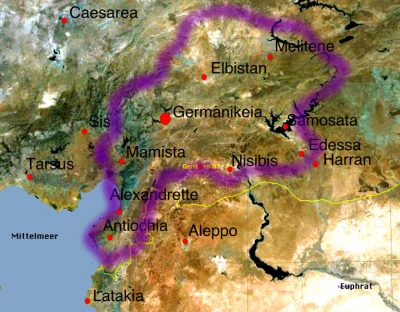Toponym
The original placename was Ablasta (Armenian: Աբլաստա – Ablasta), in Kurdish Albistan.
History
In the late Bronze Age, Elbistan was part of Kizzuwatna as Lawazantiza and was eventually annexed to the Hittite Empire under Šuppiluliuma I (ca. 1355-1320 B.C.).
With the decline of the city of Arabissos, which was destroyed by the Hamdanids in the 10th century, the importance of Elbistan in the region grew. After the Battle of Manzikert in 1071, Ablasta was part of the domain of the former Byzantine general Philaretos Brachamios (Grk.: Φιλάρετος Βραχάμιος; Armenian: Փիլարտոս Վարաժնունի, Pilartos Varajnuni), who from Germanikeia (Maraş) tried to hold together the remnants of the empire in the southwest. Between 1097 and 1105, Ablasta belonged to the Crusaders. Later, Ablasta/Elbistan often alternated between the Danishmends, the Seljuks of Rum, and the Principality of Antioch until 1201, when it became part of the Seljuk Empire.
In 1277, the Mamluks of Egypt defeated the Chupanids of Iran here. From 1339 Elbistan was the capital of the Dulkadir dynasty. The city of Elbistan was sacked and destroyed by Timur in 1400 and by the Iranian Safavids in 1507. In 1515 the Ottomans conquered Elbistan.
Armenian Population
According to the 1914 pre-war census of the Armenian Apostolic Patriarchate of Constantinople, there lived 5,838 Armenians in four localities of the kaza. They maintained four churches and four schools with an enrolment of 265 pupils.[1]
Destruction
“In the kaza of Elbistan, located in the northeastern part of the mutesarifat of Marash, the deportations targeted nearly six thousand Armenians, nearly four thousand of whom lived in the seat of the kaza and the neighboring village of Bavurköy. Operations here were overseen by the kaymakam, Hüseyin Derviş Bey. Kate Ainslie, a missionary, notes that the authorities made the deportees from Elbistan take a particularly mountainous route, circumventing Zeitun, so that they needed almost a week to reach Marash. From there they were sent toward Ayntab [Antep] and Aleppo.”[2]
